©Copyright 2018 GEOSCIENCE RESEARCH INSTITUTE
11060 Campus Street • Loma Linda, California 92350 • 909-558-4548

CORAL REEF GROWTH
by
Ariel A. Roth
Geoscience Research Institute
On a quiet moonlight night in the year 1890, the British-Indian liner Quetta was traveling through the Torres Strait near Thursday Island in northern Australia. This strait is located at the northern end of the Great Barrier Reef, the world's largest coral reef complex. Suddenly the ship hit a reef pinnacle that ripped through two-thirds of its bottom and sank within three minutes. Nearly half of the ship's 293 passengers perished as a result of this unexpected encounter. The strait had been carefully charted between 1802 and 1860, and no reef was expected where the ship foundered. Some have wondered (e.g., Ladd 1961) if possibly a reef could have grown fast enough between the time of sounding and 1890 to cause this tragedy.
The question of the rate of coral reef growth is of considerable interest not only because reefs are incipient navigational hazards, but also because of the time required to build these large structures. A number of unsolved questions related to slow rates of subsidence or sea level rise and rapid rates needed to drown a reef (e.g., Schlager 1979) are of considerable academic interest. Some also wonder if the few thousand years proposed for life on earth in a biblical context can account for the growth of these huge structures. The Great Barrier Reef of Australia does not appear to pose a problem here. While it is over 2000 km long and up to 320 km offshore, drilling operations down through this structure have run into quartz sand (a non-reef type of sediment) at less than 200 meters (Stoddart 1969), indicating that it is a very shallow structure that does not necessarily require a vast amount of time for development. On the other hand, drilling operations on Enewetak (Eniwetok) Atoll (Figure 1) in the Western Pacific have gone through 1405 m of apparent reef material before reaching a basalt rock base (Ladd and Schlanger 1960). The rates of growth assumed by most investigators would dictate that at least scores of thousands of years would be required to grow a reef this thick. We shall evaluate the basis for these rates but will first consider a few of the peculiarities of the organisms involved.
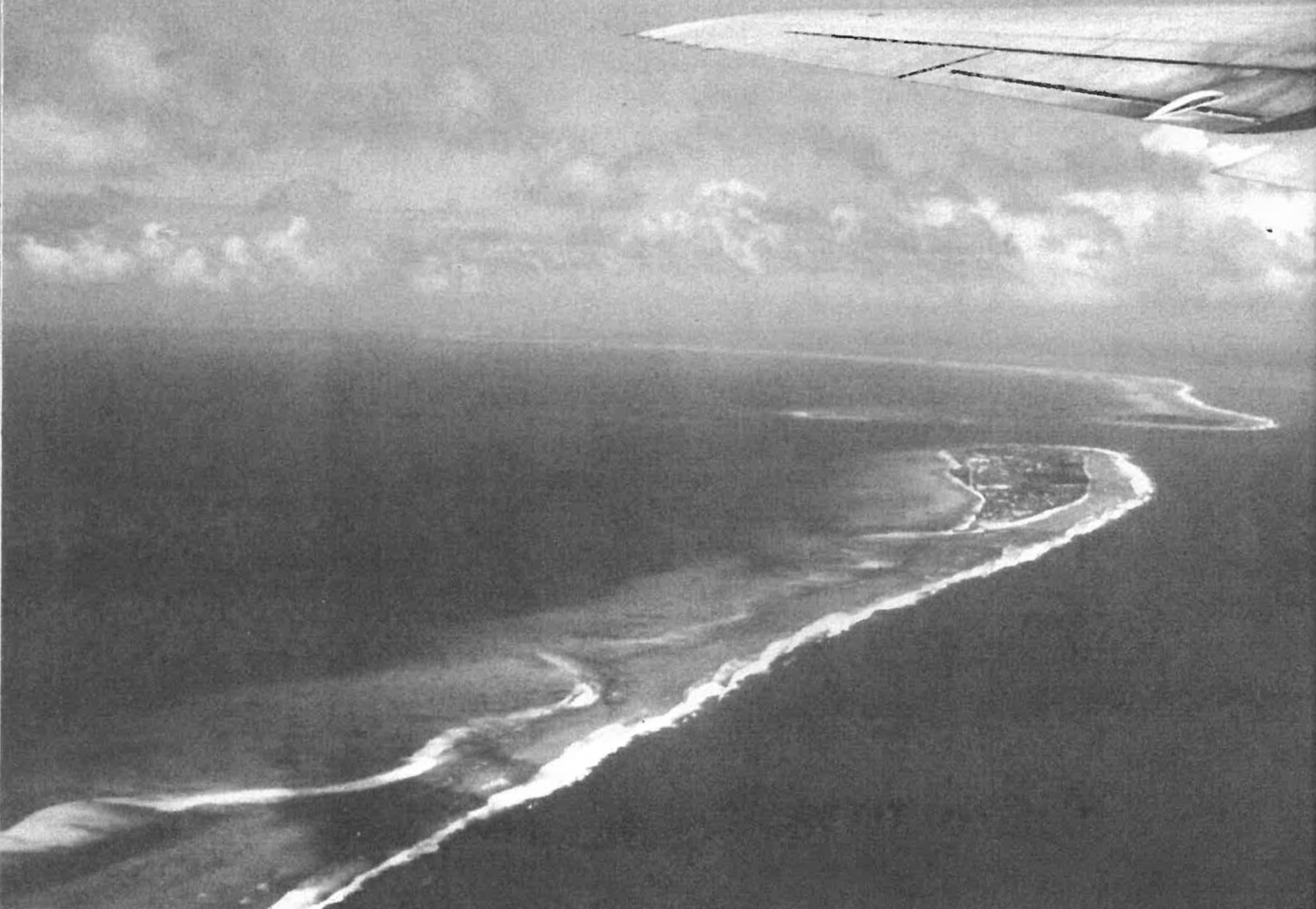
Coral reefs are produced by a variety of organisms that precipitate carbonates (lime) from seawater. Molluscs, foraminifera, and bryozoa can provide substantial amounts of carbonate for reef growth; however, coral and coralline algae are considered to be the most important contributors. Warm temperature appears to be essential for coral reef growth which is limited to the warmer waters of the tropical and western portions of the world oceans. Light is also important for coral reef growth. Coral are colonial animals (Figure 2), many of which harbor symbiotic algal plants that require light. One will not get the luxuriant type of growth necessary for live reef survival without light. This is illustrated by a number of "drowned" (essentially dead) reefs that are found from a few meters to over a kilometer down in the ocean (Macintyre 1972; Shepard 1973, p. 354; Ladd, Newman and Sohl 1974; Purdy 1974).
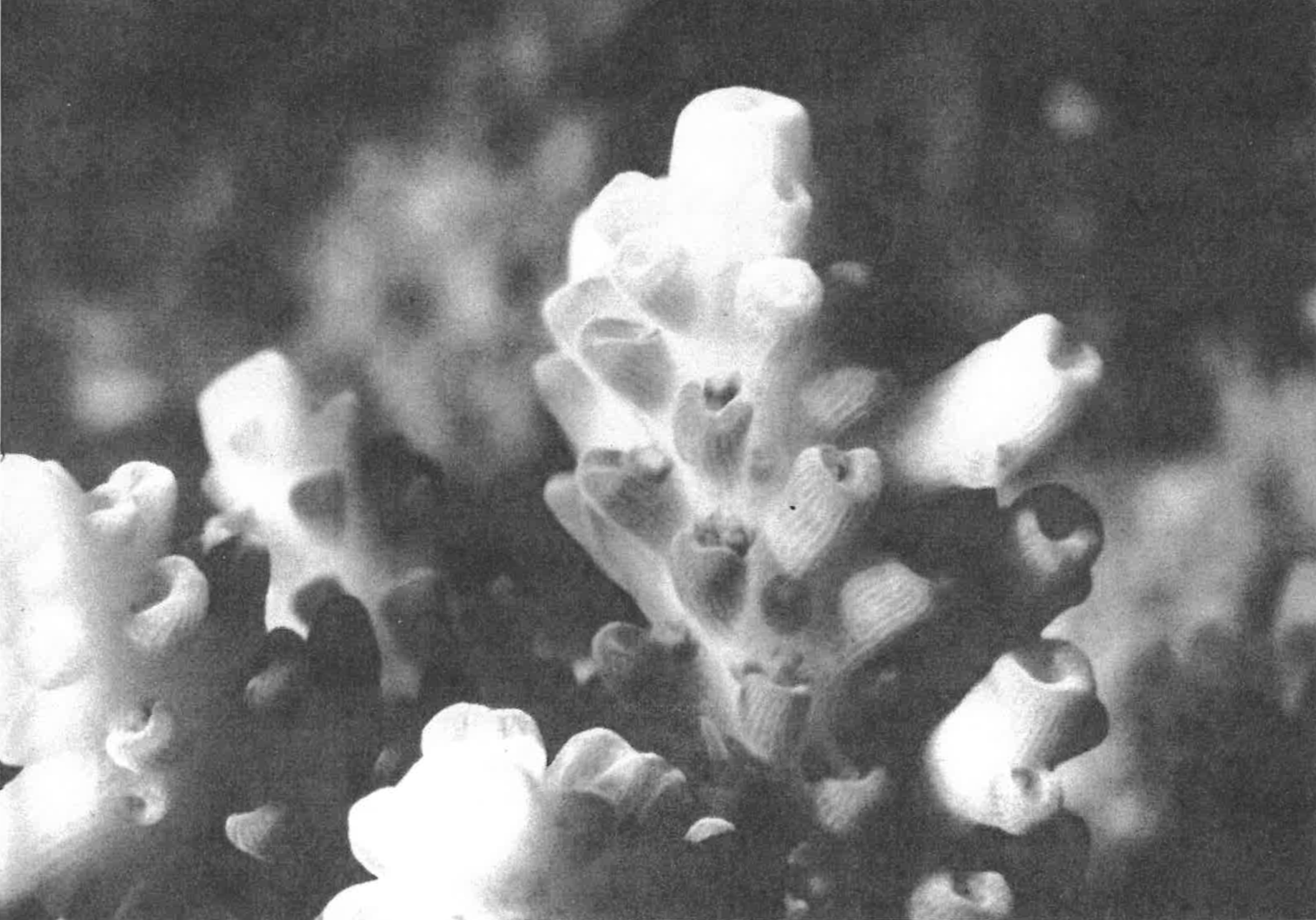
I have noted that significant coral growth stops below a depth of 50 m at Enewetak. If light is so essential to reef growth, one may wonder how reefs such as Enewetak extend to a depth of 1405 m in the sea where virtually complete darkness prevails. The present explanation is that in the past, that portion of the floor of the Pacific Ocean on which Enewetak grew was at sea level and has gradually subsided as reef growth proceeded at or near the surface of the ocean.
Coral reefs present an interesting array of other fascinating enigmas related to their morphology, nutrition and survival which are, unfortunately, beyond the scope of this brief note.
Rates of coral and coral reef growth have been studied by a number of investigators. Chave, Smith and Roy (1972) have analyzed some of the findings of other investigators and suggest net rates of growth of 0.8 to 26 mm/year. The net growth rate of a reef is the combination of total carbonate production less carbonate losses by biological, chemical and physical factors. Odum and Odum (1955) suggest a growth rate of 80 mm/year. Smith and Kinsey (1976), using an analysis of the CO2 system in seawater, suggest growth of 2-5 mm/year. Adey (1978) feels that this figure is too low for Atlantic reefs that must grow 2-3 times faster.
The figures given above contrast sharply with some figures based on actual soundings of reefs. Sewell (1935) reported 280 mm/year in the Andaman Islands in the Bay of Bengal, and Verstelle (1932) reported a maximum rate of growth of 414 mm/year in the Celebes. This latter figure would allow for the development of the 1405 m of the Enewetak reef in less than 3400 years.
One wonders why there should be a difference of one to two orders of magnitude between the estimates usually based on rates of coral growth and on soundings. A few suggestions follow. 1) Most of the estimates of coral reef growth are based on growth rates at the surface of a reef. Experiments which I have conducted indicate that at the surface of the sea, natural ultraviolet light inhibits coral growth; however, the effects do not seem to be sufficient to account for the two orders of magnitude difference obtained between surface measurements and soundings conducted at greater depth. 2) The reef surface where most studies are conducted may be a poor place to evaluate potential reef growth. Reef-building organisms are occasionally killed by exposure to air during very low tides, and further upward growth results in increased harmful exposure. For example, a slowly sinking ocean floor would tend to lower the reef below the ocean surface, where more rapid growth would be possible and, in fact, necessary to keep it from dropping too far below the surface. In contrast, reefs that are already at the ocean surface are inhibited from growing into the air. 3) An additional factor is that the rate of growth of coral and other organisms on the reef may not be the only source of carbonate with which to build a reef. Schroeder and Zankl (1974) point out that the reef can act as a filter, trapping some of the suspended carbonate load from the seawater passing through. Apparently, sediments on or near the bottom of the ocean could also contribute to reef growth, since Lonsdale, Normark and Newman (1972) found that the net movement of sand along the sides of Horizon Guyot (a submerged flat-topped mountain reaching up 3 km from the Pacific Ocean floor) is upslope, being moved up by tidal currents. Under similar circumstances, some of the rapidly growing coral near the surface of a reef (Figure 3) would facilitate more rapid carbonate deposition by trapping sediments brought upslope along the reef. In this situation the live coral would not have to build the entire mass of the reef, but only build a framework to hold the sediments.
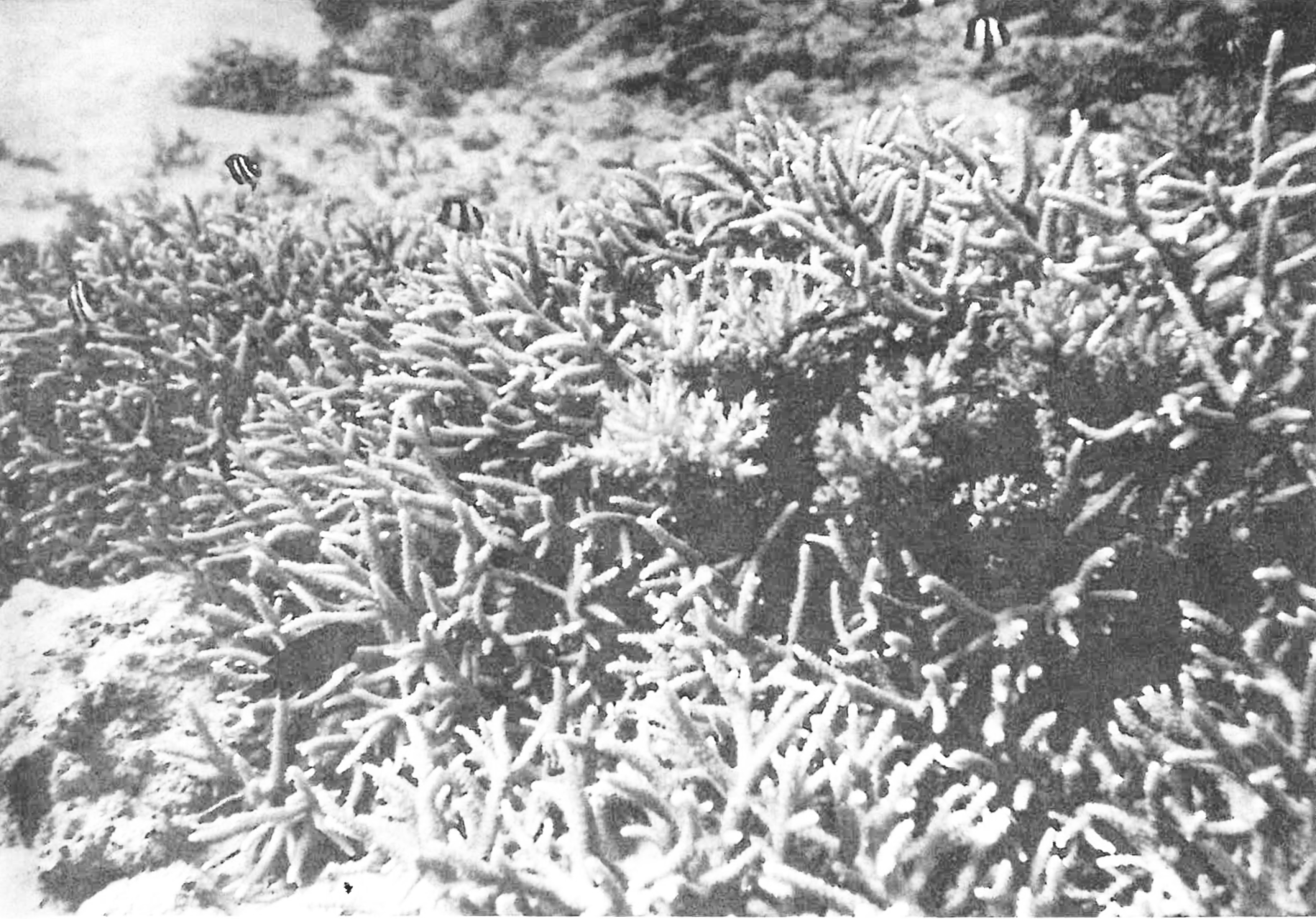
The fastest growth rate reported for any coral is the staghorn species Acropora cervicornis (Figure 4). Lewis et al. (1968) found in Jamaica a maximum rate of 264 mm/year. Shinn (1976) studied the growth of this species following destruction in a hurricane near Florida. He estimated linear growth rates of 100 mm/year. He also found that because of the branching habit (several new branches added to a single previous one) much more than the linear growth of a single branch is involved in establishing a dense stand of this coral (see Figure 3 for an example). Under these branching growth conditions, carbonate production would be more geometric than linear and could contribute further to the carbonate mass of the reef. Gladfelter, Monahan and Gladfelter (1978) report rates of 99 mm/year for Acropora palmata in the Virgin Islands. Some massive corals (Figure 5) grow much more slowly.
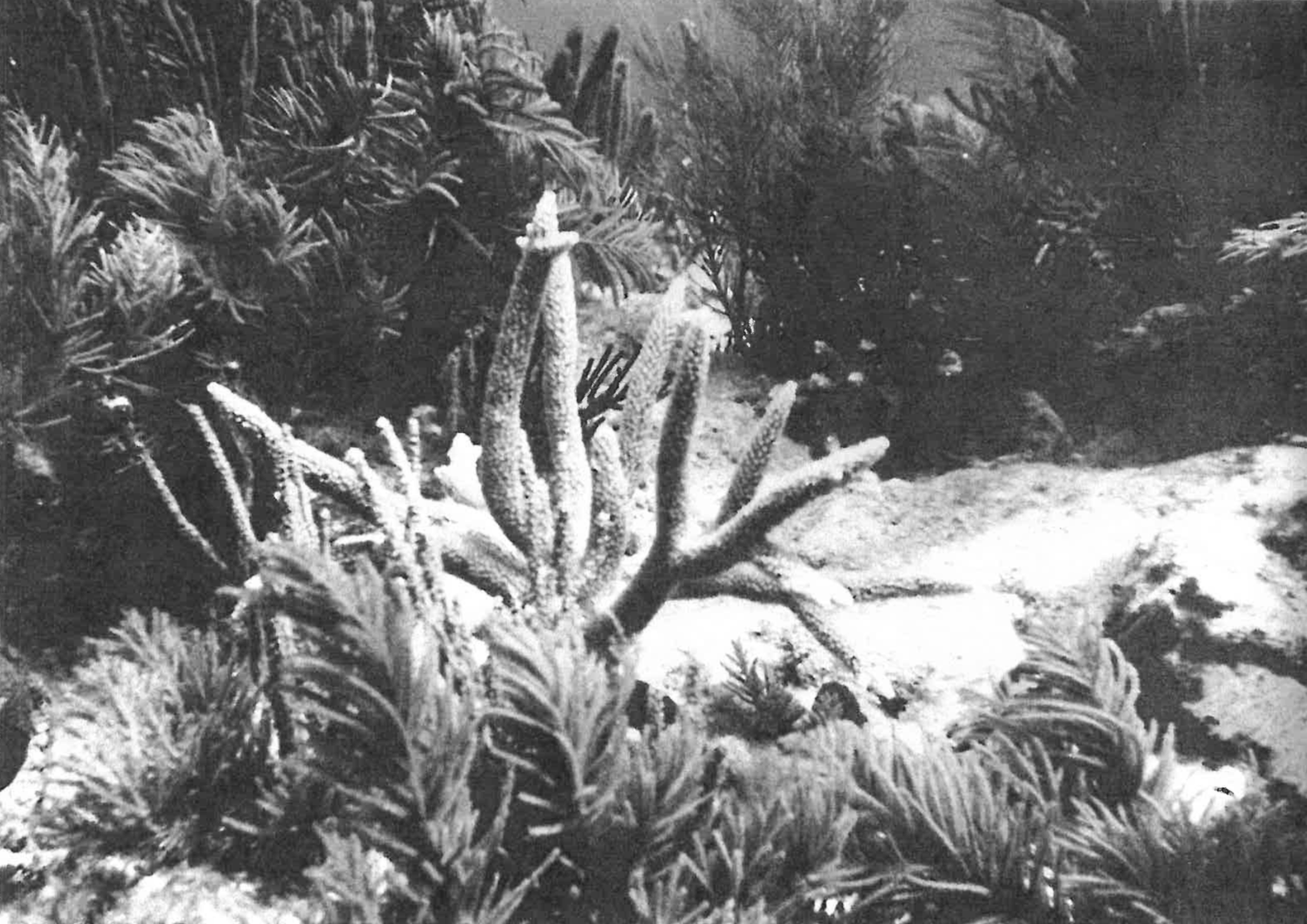
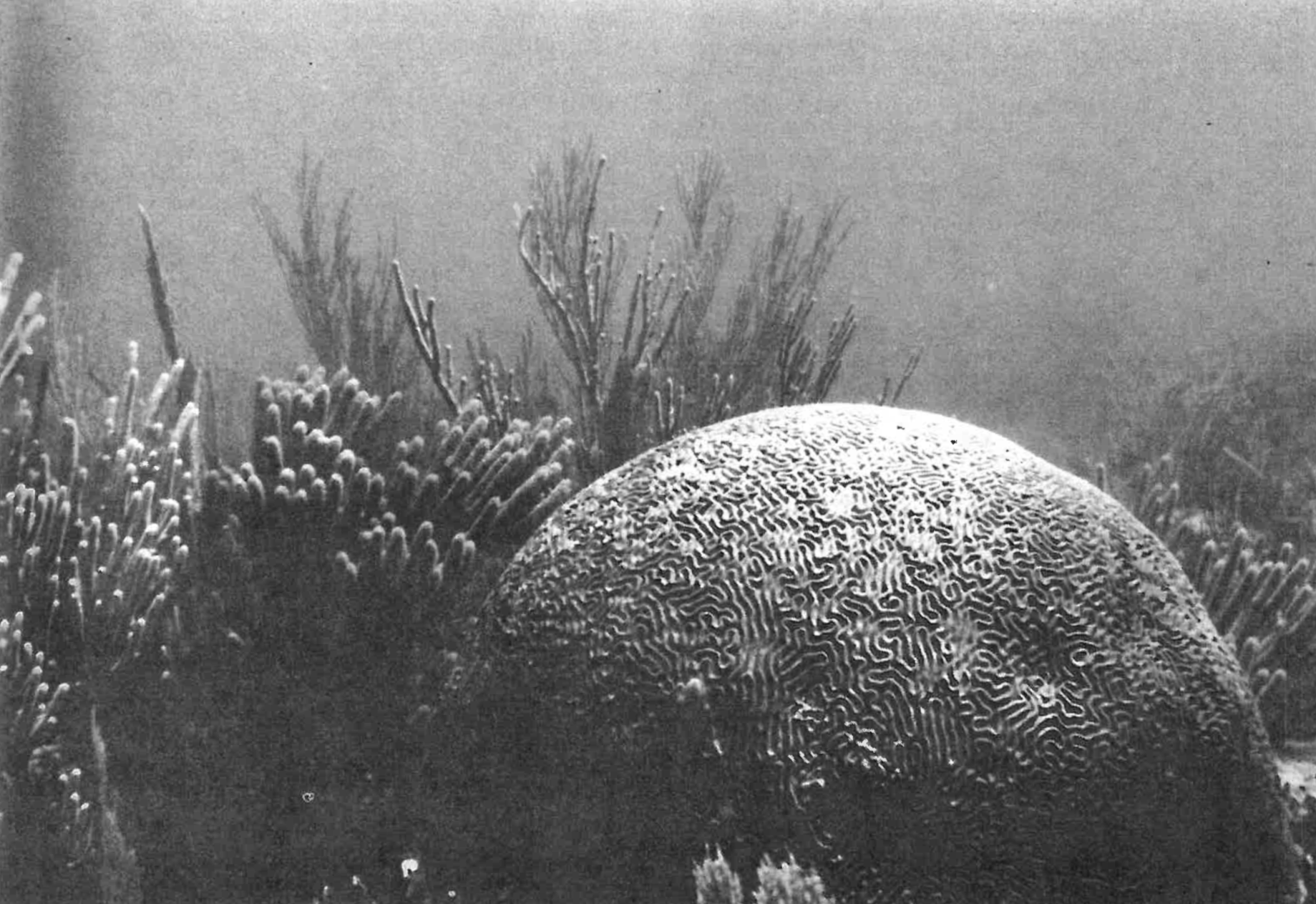
The upslope movement of sediment along reefs may be enhanced near the surface by the occasional action of typhoons. Maragos, Baines and Beveridge (1973) reported that in 1972 a rampart of coral rubble 3.5 m high, 37 m wide, and 18 km long was brought up from below the surface at Funafuti Atoll in a few hours during Cyclone Bebe. Blocks of coral 2 meters high were brought up on Jaluit Atoll (another Pacific reef) during another typhoon in 1958. A new rampart was also formed there (Wiens 1962, Plates 19 and 35).
The three main factors mentioned above indicate that reef growth can be much faster than surficial measurements would indicate. They may explain the major discrepancies between reported rates of reef growth. However, before any final conclusions can be arrived at, one must also take into consideration those factors that contribute to the attrition of reefs. These include: 1) destruction by corallivores (boring organisms) (Macintyre 1972), 2) possible chemical breakdown, and 3) mechanical destruction by waves and downslope movement along the edge of the reef.
Experiments that my graduate students and I have conducted indicate that one can, at least temporarily, nearly double the rate of coral growth by raising the temperature 5ºC or by increasing the carbonate ion content of seawater. What relationship this might have to past rates of coral reef growth remains to be investigated. Nevertheless a number of facts indicate that coral reef growth rates may be much faster than some of the slower estimates reported in the literature. Our present knowledge does not preclude rapid rates of development; some factors definitely facilitate it.
REFERENCES
- Adey, W.H. 1978. Coral reef morphogenesis: a multidimensional model. Science 202:831-837.
- Chave, K.E., S.V. Smith, and K.J. Roy. 1972. Carbonate production by coral reefs. Marine Geology 12:123-140.
- Gladfelter, E.H., R.K. Monahan, and W.B. Gladfelter. 1978. Growth rates of five reef-building corals in the northeastern Caribbean. Bulletin of Marine Science 28:728-734.
- Ladd, H.S. 1961. Reef building. Science 134:703-715.
- Ladd, H.S., W.A. Newman, and N.F. Sohl. 1974. Darwin Guyot, the Pacific's oldest atoll. Proceedings of the Second International Coral Reef Symposium 2:513-522.
- Ladd, H.S., and S.O. Schlanger. 1960. Drilling operations on Eniwetok Atoll, Bikini and nearby atolls, Marshall Islands. U.S. Geological Survey Professional Paper 260Y:863-905.
- Lewis, J.B., F. Axelsen, I. Goodbody, C. Page, and G. Chislett. 1968. Comparative growth rates of some reef corals in the Caribbean. Marine Sciences Manuscript Report 10. McGill University.
- Lonsdale, P., W.R. Normark, and W.A. Newman. 1972. Sedimentation and erosion on Horizon Guyot. Geological Society of America Bulletin 83:289-316.
- Macintyre, I.G. 1972. Submerged reefs of eastern Caribbean. American Association of Petroleum Geologists 56:720-738.
- Maragos, J.E., G.B.K. Baines, and P.J. Beveridge. 1973. Tropical cyclone Bebe creates a new land formation on Funafuti Atoll. Science 181:1161-1164.
- Odum, H.T. and E.P. Odum. 1955. Trophic structure and productivity of a windward coral reef community on Eniwetok Atoll. Ecological Monographs 25(3):291-320.
- Purdy, E.G. 1974. Reef configurations: cause and effect. In L.F. Laporte, ed. Reefs in Time and Space, pp. 9-76. Society of Economic Paleontologists and Mineralogists Special Publication 18.
- Schlager, W. 1979. Drowning of carbonate platforms. Geological Society of America Abstracts 11(7):511-512.
- Schroeder, J.H. and H. Zankl. 1974. Dynamic reef formation: a sedimentological concept based on studies of Recent Bermuda and Bahama reefs. Proceedings of the Second International Coral Reef Symposium 2:413-428.
- Sewell, R.B.S. 1935. Studies on coral and coral-formations in Indian waters. Geographic and Oceanographic Research in Indian Waters No. 8. Memoirs of the Asiatic Society of Bengal 9:461-539.
- Shepard, F.P. 1973. Submarine geology. 3rd ed. Harper & Row, New York.
- Shinn, E.A. 1976. Coral reef recovery in Florida and the Persian Gulf. Environmental Geology 1:241-254.
- Smith, S.V. and D.W. Kinsey. 1976. Calcium carbonate production, coral reef growth, and sea level change. Science 194:937-939.
- Stoddart, D.R. Ecology and morphology of Recent coral reefs. Biological Reviews 44:433-498.
- Verstelle, J. Th. 1932. The growth rate at various depths of coral reefs in the Dutch East Indian Archipelago. Treubia 14:117-126.
- Wiens, H.J. 1962. Atoll environment and ecology. Yale University Press, New Haven and London.